Sequential actions of BMP receptors control neural precursor cell production and fate
- PMID: 11511541
- PMCID: PMC312756
- DOI: 10.1101/gad.894701
Sequential actions of BMP receptors control neural precursor cell production and fate
Abstract
Bone morphogenetic proteins (BMPs) have diverse and sometimes paradoxical effects during embryonic development. To determine the mechanisms underlying BMP actions, we analyzed the expression and function of two BMP receptors, BMPR-IA and BMPR-IB, in neural precursor cells in vitro and in vivo. Neural precursor cells always express Bmpr-1a, but Bmpr-1b is not expressed until embryonic day 9 and is restricted to the dorsal neural tube surrounding the source of BMP ligands. BMPR-IA activation induces (and Sonic hedgehog prevents) expression of Bmpr-1b along with dorsal identity genes in precursor cells and promotes their proliferation. When BMPR-IB is activated, it limits precursor cell numbers by causing mitotic arrest. This results in apoptosis in early gestation embryos and terminal differentiation in mid-gestation embryos. Thus, BMP actions are first inducing (through BMPR-IA) and then terminating (through BMPR-IB), based on the accumulation of BMPR-IB relative to BMPR-IA. We describe a feed-forward mechanism to explain how the sequential actions of these receptors control the production and fate of dorsal precursor cells from neural stem cells.
Figures

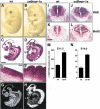

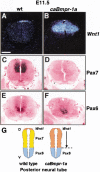
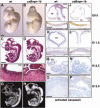
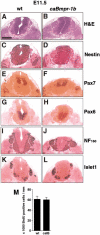
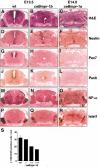

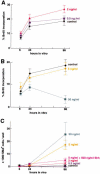

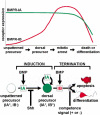
Similar articles
-
Bone morphogenetic proteins.Growth Factors. 2004 Dec;22(4):233-41. doi: 10.1080/08977190412331279890. Growth Factors. 2004. PMID: 15621726 Review.
-
Utilization of bone morphogenetic protein receptors during chondrocyte maturation.J Bone Miner Res. 2000 Aug;15(8):1630-9. doi: 10.1359/jbmr.2000.15.8.1630. J Bone Miner Res. 2000. PMID: 10934663
-
A kinase domain-truncated type I receptor blocks bone morphogenetic protein-2-induced signal transduction in C2C12 myoblasts.J Biol Chem. 1997 Aug 29;272(35):22046-52. doi: 10.1074/jbc.272.35.22046. J Biol Chem. 1997. PMID: 9268344
-
Identification of type I and type II serine/threonine kinase receptors for growth/differentiation factor-5.J Biol Chem. 1996 Aug 30;271(35):21345-52. doi: 10.1074/jbc.271.35.21345. J Biol Chem. 1996. PMID: 8702914
-
The crystal structure of the BMP-2:BMPR-IA complex and the generation of BMP-2 antagonists.J Bone Joint Surg Am. 2001;83-A Suppl 1(Pt 1):S7-14. J Bone Joint Surg Am. 2001. PMID: 11263668 Review.
Cited by
-
The multiple activities of BMPs during spinal cord development.Cell Mol Life Sci. 2013 Nov;70(22):4293-305. doi: 10.1007/s00018-013-1354-9. Epub 2013 May 15. Cell Mol Life Sci. 2013. PMID: 23673983 Free PMC article. Review.
-
Non-invasive neural stem cells become invasive in vitro by combined FGF2 and BMP4 signaling.J Cell Sci. 2013 Aug 15;126(Pt 16):3533-40. doi: 10.1242/jcs.125757. Epub 2013 Jun 20. J Cell Sci. 2013. PMID: 23788430 Free PMC article.
-
Specific Preferences in Lineage Choice and Phenotypic Plasticity of Glioma Stem Cells Under BMP4 and Noggin Influence.Brain Pathol. 2016 Jan;26(1):43-61. doi: 10.1111/bpa.12263. Epub 2015 May 19. Brain Pathol. 2016. PMID: 25808628 Free PMC article.
-
Noggin overexpression inhibits eyelid opening by altering epidermal apoptosis and differentiation.EMBO J. 2003 Jun 16;22(12):2992-3003. doi: 10.1093/emboj/cdg291. EMBO J. 2003. PMID: 12805214 Free PMC article.
-
Cell-Biological Requirements for the Generation of Dentate Gyrus Granule Neurons.Front Cell Neurosci. 2018 Nov 12;12:402. doi: 10.3389/fncel.2018.00402. eCollection 2018. Front Cell Neurosci. 2018. PMID: 30483057 Free PMC article. Review.
References
-
- Altmann CR, Brivanlou AH. Neural patterning in the vertebrate embryo. Int Rev Cytol. 2001;203:447–482. - PubMed
-
- Amthor H, Christ B, Weil M, Patel K. The importance of timing differentiation during limb muscle development. Curr Biol. 1998;8:642–652. - PubMed
-
- Amthor H, Christ B, Patel K. A molecular mechanism enabling continuous embryonic muscle growth: A balance between proliferation and differentiation. Development. 1999;126:1041–1053. - PubMed
-
- Arkell R, Beddington RS. BMP-7 influences pattern and growth of the developing hindbrain of mouse embryos. Development. 1997;124:1–12. - PubMed
-
- Bachiller D, Klingensmith J, Kemp C, Belo JA, Anderson RM, May SR, McMahon JA, McMahon AP, Harland RM, Rossant J, et al. The organizer factors Chordin and Noggin are required for mouse forebrain development. Nature. 2000;403:658–661. - PubMed
MeSH terms
Substances
LinkOut - more resources
Full Text Sources
Other Literature Sources
Molecular Biology Databases
